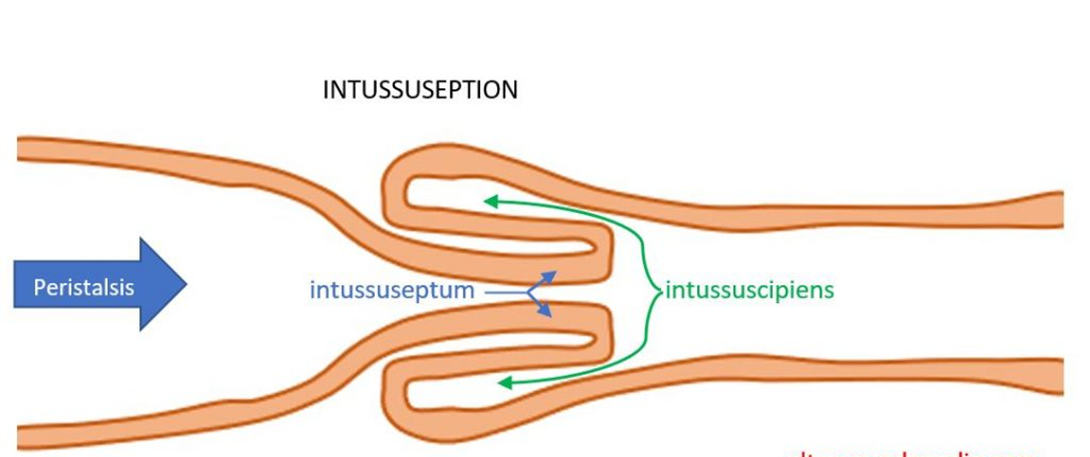A nurse is caring for a male infant who has a palpable mass in the upper right quadrant and stools mixed with blood and mucus. The nurse should recognize that which of the following diagnoses is associated with these findings?
Hypertrophic pyloric stenosis
Intussusception
Inguinal hernia
Tracheoesophageal fistula
The Correct Answer is B
Choice A reason: Hypertrophic pyloric stenosis is a condition in which the pyloric sphincter becomes thickened and obstructs the passage of food from the stomach to the duodenum. It causes projectile vomiting, dehydration, and weight loss, but not a palpable mass or bloody stools.
Choice B reason: Intussusception is a condition in which a segment of the intestine telescopes into another segment, causing obstruction, inflammation, and ischemia. It causes a palpable mass in the upper right quadrant, abdominal pain, and stools mixed with blood and mucus, also known as "currant jelly" stools.
Choice C reason: Inguinal hernia is a condition in which a part of the intestine protrudes through a weak spot in the abdominal wall near the inguinal canal. It causes a bulge in the groin area, especially when the infant cries or strains. It does not cause a mass in the upper right quadrant or bloody stools.
Choice D reason: Tracheoesophageal fistula is a congenital anomaly in which there is an abnormal connection between the trachea and the esophagus. It causes excessive drooling, choking, coughing, and cyanosis during feeding, but not a palpable mass or bloody stools.

Nursing Test Bank
Naxlex Comprehensive Predictor Exams
Related Questions
Correct Answer is B
Explanation
Choice A reason: The child has a normal potassium level, as it is within the reference range of 3.5 to 5 mEq/L. Potassium is an electrolyte that helps regulate the fluid balance, nerve impulses, and muscle contractions in the body.
Choice B reason: The child has a low hemoglobin level, as it is below the reference range of 10 to 15.5 g/dL. Hemoglobin is a protein in the red blood cells that carries oxygen to the tissues. Sickle cell anemia is a genetic disorder that causes the red blood cells to have an abnormal shape and become rigid, sticky, and prone to clumping. This can lead to hemolysis, anemia, and reduced oxygen delivery.
Choice C reason: The child has a normal platelet level, as it is within the reference range of 150,000 to 450,000 mm^3^. Platelets are blood cells that help with clotting and prevent bleeding. Sickle cell anemia can cause thrombocytopenia, a low platelet count, due to increased destruction or sequestration of platelets in the spleen.
Choice D reason: The child has a normal blood glucose level, as it is within the reference range of 70 to 110 mg/dL. Blood glucose is the main source of energy for the cells in the body. Sickle cell anemia can cause hypoglycemia, a low blood glucose level, due to impaired glucose metabolism, increased glucose utilization, or decreased glucose production.
Correct Answer is D
Explanation
The correct answer is: D
Choice A reason:
Placing an infant on their left side after feeding is not the most recommended position for managing gastroesophageal reflux (GER). While it may be better than lying flat on the back, it does not provide the same benefits as keeping the infant in an upright position.
Choice B reason:
Positioning an infant on their right side is generally not advised for GER management. This position can potentially worsen reflux as it may facilitate the backflow of stomach contents into the esophagus due to the stomach's anatomical orientation.
Choice C reason:
Placing an infant in a prone position, especially after feeding, is strongly discouraged due to the increased risk of sudden infant death syndrome (SIDS). Although this position may reduce gastroesophageal reflux, the potential risks far outweigh the benefits.
Choice D reason:
Placing an infant in an infant seat is the recommended position following feedings for a child with GER. This position helps keep the infant upright, allowing gravity to aid in keeping the stomach contents from coming back up into the esophagus. However, it's important to note that the infant seat should not be inclined, as semi-supine positioning can exacerbate GER.
Whether you are a student looking to ace your exams or a practicing nurse seeking to enhance your expertise , our nursing education contents will empower you with the confidence and competence to make a difference in the lives of patients and become a respected leader in the healthcare field.
Visit Naxlex, invest in your future and unlock endless possibilities with our unparalleled nursing education contents today
Report Wrong Answer on the Current Question
Do you disagree with the answer? If yes, what is your expected answer? Explain.
Kindly be descriptive with the issue you are facing.
